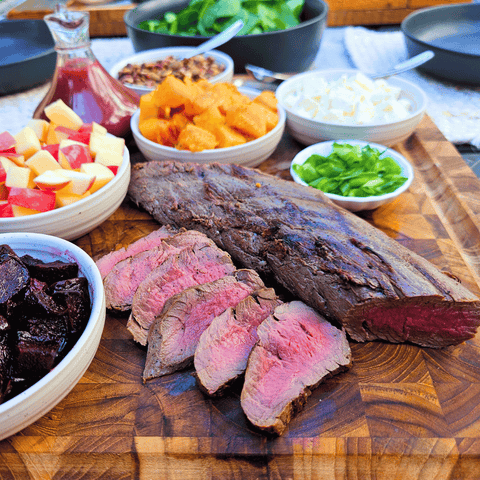Elk and bison tenderloin are the most tender, lean cuts of meat, prized for their delicate texture and mild, slightly sweet flavor. Unlike ribeye or chuck, tenderloin has almost no intramuscular fat (marbling) and minimal connective tissue (collagen). This makes them fast-cooking, but also very easy to overcook.
Unlike fattier beef cuts, overcooking tenderloin forces out its natural juices, leaving the meat dry, tough, and stripped of flavor. Tenderloin does not respond well to slow cooking, braising, or pressure cooking. While it might seem like you can throw any cut of meat into the Instant Pot, tenderloin is an exception. These methods overbreak its delicate fibers, leaving the meat mushy and dulling its naturally sweet, wild flavor.
Tenderloin also benefits from quick, high-heat cooking and careful handling. Bringing the meat to room temperature before cooking, adding a bit of fat, and resting it after cooking will ensure it stays juicy and flavorful. The right technique allows the tenderloin to develop a beautiful crust, retain its natural tenderness, and deliver a rich, wild flavour without drying out.
You can learn all about cooking all cuts of elk meat in this article.

Tenderloin: How Not to Cook It
-
Slow-cook, braise, or use an Instant Pot – These methods are for tougher cuts, not lean tenderloin.
-
Overcook – Going past medium-rare dries out the meat and makes it chewy.
-
Skip the sear – Low heat alone won’t give a flavorful crust or caramelized exterior.
-
Cook straight from the fridge – Cold meat cooks unevenly and won’t sear properly.
-
Cook without fat – Butter, oil, or tallow helps keep tenderloin moist.
-
Over-marinating in acids – Lemon, vinegar, or pineapple for too long makes the meat mushy.
-
Cook over flare-ups or uneven heat – Lean tenderloin burns easily.
-
Skip resting – Juices escape immediately if sliced too soon.
Tenderloin: How To Cook It
-
Cook rare to medium-rare – 120–125°F for elk, 125–130°F for bison steaks.
-
High-heat searing – Use a cast-iron skillet, hot grill, or sous vide with finishing sear for a golden crust.
-
Bring to room temperature first – 20–30 minutes ensures even cooking and a perfect sear.
-
Add fat – Baste with butter, tallow or oil as it sears to lock in moisture.
-
Short, flavorful marinades or rubs – 30–60 minutes max if using acids; otherwise, stick to dry rubs or spice blends.
-
Control heat – Keep the grill or pan hot but steady; avoid flare-ups.
-
Rest after cooking – 5–10 minutes lets juices redistribute, keeping the meat juicy.
-
Finish with compound butter (optional) – Adds richness and a touch of flavor, perfect for delicate game meat.
-
Grill option – Quick, direct-heat grilling works beautifully for thin tenderloin steaks; aim for 2–3 minutes per side depending on thickness.
Tenderloin Cheat Sheet

Now you know the best and worst ways to prepare a wild game tenderloin, why not give it a try? We have lots of ideas to get you started; you can find all of our Tenderloin recipes here.


